What is the normal range for ast. AST Blood Test: Understanding Normal Ranges and Interpreting Results
What is the normal range for AST (Aspartate aminotransferase). How is the AST blood test performed. What do abnormal AST levels indicate. When should you be concerned about your AST results.
What is Aspartate Aminotransferase (AST) and Its Function?
Aspartate aminotransferase (AST) is an enzyme primarily found in the liver, but it’s also present in other organs such as the heart, muscles, and kidneys. As an enzyme, AST plays a crucial role in facilitating specific chemical changes within the body. Its main function is to catalyze the transfer of amino groups between amino acids, which is essential for various metabolic processes.
The concentration of AST in the blood is typically low under normal circumstances. However, when liver cells are damaged or die, they release AST into the bloodstream, causing its levels to rise. This makes AST an important biomarker for assessing liver health and function.
Other Names for AST
- Serum Glutamic-Oxaloacetic Transaminase (SGOT)
- Aspartate Transaminase
The AST Blood Test: Purpose and Procedure
The AST blood test is a common diagnostic tool used to measure the level of AST enzyme in the blood. This test is primarily performed to assess liver function and detect potential liver damage or disease. However, it can also provide insights into the health of other organs where AST is present, such as the heart and muscles.
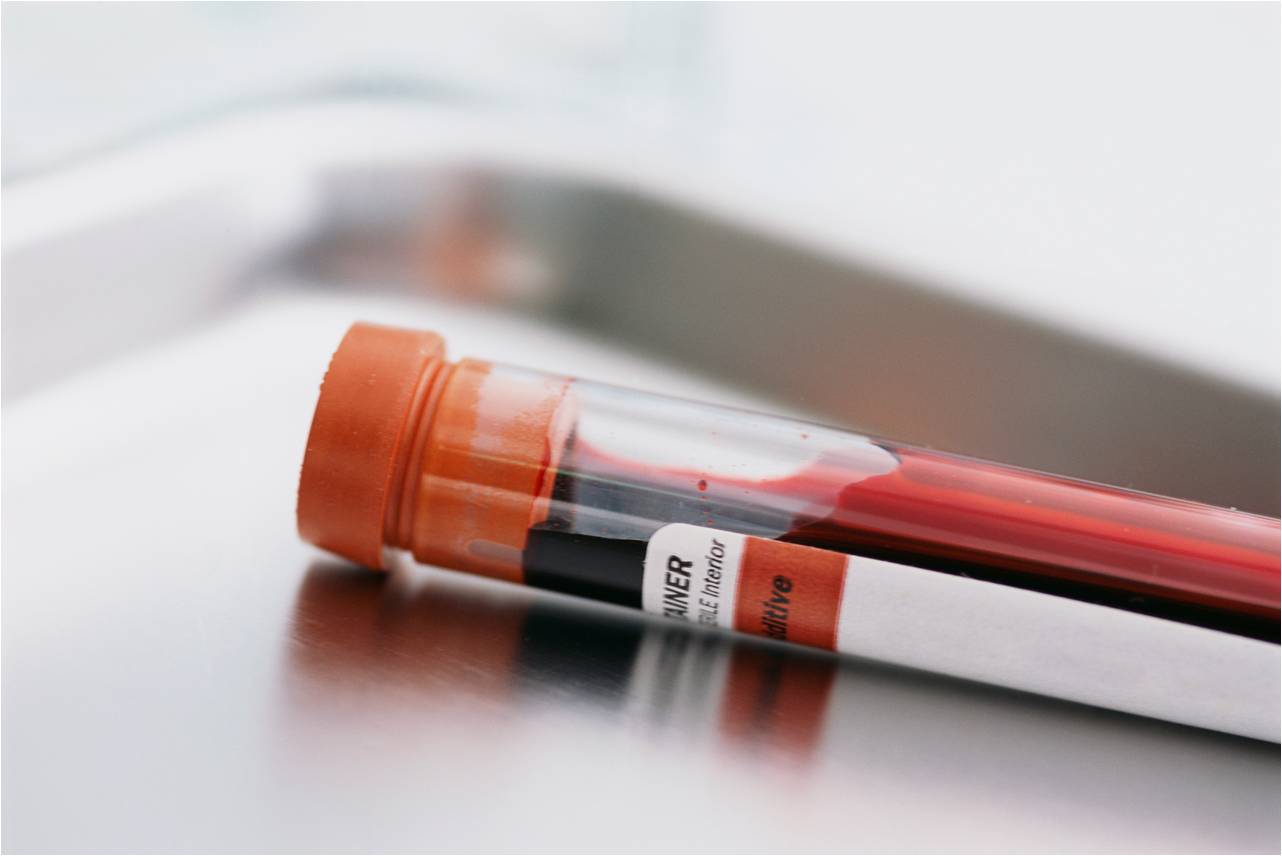
How is the AST Blood Test Performed?
The AST blood test is a straightforward procedure that involves drawing a blood sample from a vein, typically in the arm. Here’s what you can expect during the test:
- A healthcare professional will clean the area where the blood will be drawn, usually the inside of the elbow or back of the hand.
- An elastic band is tied around the upper arm to make the vein more visible and easier to access.
- A needle is gently inserted into the vein to collect the blood sample.
- The blood is drawn into a vial or tube.
- The needle is removed, and pressure is applied to stop any bleeding.
- The sample is then sent to a laboratory for analysis.
The entire process usually takes less than five minutes. While some people may experience slight discomfort or a brief stinging sensation during the needle insertion, the procedure is generally well-tolerated.
Preparation for the AST Blood Test
One of the advantages of the AST blood test is that it requires minimal preparation. In most cases, no special preparations are needed before the test. However, it’s always best to consult with your healthcare provider beforehand, as they may have specific instructions based on your individual health situation or other tests that might be performed simultaneously.

Normal AST Levels: What’s the Healthy Range?
Understanding the normal range for AST levels is crucial for interpreting test results accurately. However, it’s important to note that the exact range can vary slightly depending on the laboratory and the specific testing methods used.
Generally, the normal range for AST levels in adults is considered to be between 8 and 33 U/L (units per liter). However, some laboratories may use different units of measurement or have slightly different reference ranges. It’s always best to refer to the specific range provided by the laboratory that conducted your test.
Factors Affecting AST Levels
Several factors can influence AST levels, even in healthy individuals. These include:
- Age: AST levels may naturally increase slightly with age.
- Gender: Men typically have slightly higher AST levels than women.
- Body mass: Obesity can lead to mildly elevated AST levels.
- Exercise: Intense physical activity can temporarily increase AST levels.
- Medications: Certain drugs can affect AST levels.
- Pregnancy: AST levels may fluctuate during pregnancy.
Given these variations, it’s crucial to interpret AST results in the context of an individual’s overall health profile and in conjunction with other liver function tests.

Interpreting AST Test Results: What Do They Mean?
Interpreting AST test results requires careful consideration of various factors. While the test provides valuable insights into liver health, it’s important to remember that AST levels alone don’t provide a complete picture. Healthcare providers typically analyze AST results alongside other liver function tests and clinical information to make accurate diagnoses.
Normal AST Results
If your AST levels fall within the normal range (typically 8-33 U/L), it generally indicates that your liver is functioning properly. However, it’s important to note that normal AST levels don’t necessarily rule out all liver conditions, especially in their early stages.
Elevated AST Levels
Elevated AST levels (above 33 U/L) can be indicative of liver damage or disease. However, the degree of elevation and the presence of other symptoms or abnormal test results help determine the severity and possible causes of the liver issue.
Mild elevations (1-3 times the upper limit of normal) may be due to:

- Fatty liver disease
- Mild viral hepatitis
- Alcohol consumption
- Certain medications
Moderate to severe elevations (more than 3 times the upper limit of normal) might indicate more serious conditions such as:
- Acute viral hepatitis
- Alcoholic hepatitis
- Liver cirrhosis
- Drug-induced liver injury
- Autoimmune hepatitis
Very High AST Levels
In some cases, AST levels can be extremely elevated, reaching 10-20 times the upper limit of normal. This can occur in severe liver damage scenarios such as:
- Acute liver failure
- Ischemic hepatitis (reduced blood flow to the liver)
- Severe drug-induced liver injury
Conditions Associated with Abnormal AST Levels
Abnormal AST levels can be indicative of various health conditions, primarily related to the liver but also affecting other organs. Understanding these associations can help in the diagnostic process and guide further medical investigations.
Liver-Related Conditions
The liver is the primary organ associated with AST levels. Elevated AST often points to liver damage or disease. Some common liver-related conditions include:

- Hepatitis (viral, alcoholic, or autoimmune)
- Cirrhosis
- Fatty liver disease (alcoholic and non-alcoholic)
- Liver cancer or tumors
- Drug-induced liver injury
- Hemochromatosis (iron overload)
Non-Liver Conditions
While the liver is the primary concern when AST levels are abnormal, other conditions can also affect AST levels:
- Heart conditions (e.g., heart attack, heart failure)
- Muscle disorders or injuries
- Pancreatitis
- Mononucleosis
- Burns (especially severe ones)
- Recent surgeries
It’s important to note that these conditions often affect other biomarkers as well, which is why AST is typically measured as part of a comprehensive panel of tests.
AST/ALT Ratio: A Key Diagnostic Tool
While AST levels provide valuable information on their own, they are often analyzed in conjunction with another liver enzyme called Alanine Aminotransferase (ALT). The ratio of AST to ALT, known as the AST/ALT ratio, can offer additional insights into the nature and severity of liver damage.
Understanding the AST/ALT Ratio
In a healthy liver, the AST/ALT ratio is typically around 1 or slightly less. Different ratios can suggest various liver conditions:

- AST/ALT ratio < 1: Often seen in viral hepatitis or fatty liver disease
- AST/ALT ratio > 2: May indicate alcoholic liver disease
- AST/ALT ratio > 1 but < 2: Can be seen in cirrhosis or other chronic liver diseases
However, it’s crucial to interpret this ratio in the context of other clinical information and test results. The AST/ALT ratio is a useful tool but not definitive on its own.
When to Seek Medical Attention for AST Results
Understanding when to be concerned about AST results is crucial for timely medical intervention. While minor elevations might not always be cause for immediate alarm, certain scenarios warrant prompt medical attention.
Scenarios Requiring Immediate Attention
- AST levels more than 3 times the upper limit of normal
- Rapid increase in AST levels over a short period
- Persistently elevated AST levels in multiple tests
- AST elevation accompanied by symptoms like jaundice, abdominal pain, or fatigue
- Abnormal AST levels in individuals with known liver disease or risk factors
If you encounter any of these scenarios, it’s advisable to consult with a healthcare provider promptly. They can provide a comprehensive evaluation and determine if further testing or treatment is necessary.

Follow-Up and Monitoring
For individuals with mildly elevated AST levels or those at risk of liver disease, regular monitoring may be recommended. This might involve:
- Repeat AST tests at specified intervals
- Additional liver function tests
- Imaging studies (e.g., ultrasound, CT scan)
- Lifestyle modifications to support liver health
Your healthcare provider will develop a personalized plan based on your individual health status and risk factors.
Lifestyle Factors Affecting AST Levels
Various lifestyle factors can influence AST levels, either temporarily or over the long term. Understanding these factors can help individuals maintain healthy AST levels and overall liver function.
Diet and Nutrition
A balanced diet plays a crucial role in liver health. Some dietary considerations include:
- Limiting alcohol consumption: Excessive alcohol intake can significantly elevate AST levels
- Maintaining a healthy weight: Obesity is linked to fatty liver disease, which can raise AST levels
- Eating a liver-friendly diet: Rich in fruits, vegetables, whole grains, and lean proteins
- Avoiding excessive sugar and saturated fats: These can contribute to fatty liver disease
Exercise and Physical Activity
Regular exercise is generally beneficial for liver health. However, intense physical activity can temporarily increase AST levels. This is why it’s important to inform your healthcare provider about your exercise routine before an AST test.

Medications and Supplements
Certain medications and supplements can affect AST levels. Always inform your healthcare provider about all medications and supplements you’re taking, including over-the-counter drugs and herbal remedies.
Stress Management
Chronic stress can indirectly affect liver health and potentially influence AST levels. Implementing stress-reduction techniques like meditation, yoga, or regular relaxation can support overall liver function.
By understanding and managing these lifestyle factors, individuals can play an active role in maintaining healthy AST levels and supporting their liver health. However, it’s important to remember that lifestyle changes should be made in consultation with a healthcare provider, especially for those with existing liver conditions or abnormal AST results.
Aspartate aminotransferase (AST) blood test
Medical Tests
Definition
The aspartate aminotransferase (AST) blood test measures the level of the enzyme AST in the blood.
Alternative Names
Aspartate aminotransferase; Serum glutamic-oxaloacetic transaminase; SGOT
How the Test is Performed
A blood sample is needed.
How to Prepare for the Test
No special preparation is needed.
How the Test will Feel
When the needle is inserted to draw blood, some people feel moderate pain. Others feel only a prick or stinging. Afterward, there may be some throbbing or a slight bruise. This soon goes away.
Why the Test is Performed
AST is an enzyme found in high levels in the liver, heart, and muscles. It is also found in lesser amounts in other tissues. An enzyme is a protein that causes a specific chemical change in the body.
An enzyme is a protein that causes a specific chemical change in the body.
Injury to the liver results in release of AST into the blood.
This test is mainly done along with other tests (such as ALT, ALP, and bilirubin) to diagnose and monitor liver disease.
Normal Results
The normal range is 8 to 33 U/L.
Normal value ranges may vary slightly among different laboratories. Some labs use different measurements or may test different samples. Talk to your health care provider about the meaning of your specific test results.
What Abnormal Results Mean
An increased AST level is often a sign of liver disease. Liver disease is even more likely when the levels of substances checked by other liver blood tests have also increased.
An increased AST level may be due to any of the following:
AST level may also increase after:
- Burns (deep)
- Heart procedures
- Seizure
- Surgery
Pregnancy and exercise may also cause an increased AST level.
Risks
There is little risk involved with having your blood taken. Veins vary in size from one person to another and from one side of the body to the other. Taking blood from some people may be more difficult than from others.
Risks associated with having blood drawn are slight, but may include:
- Fainting or feeling lightheaded
- Excessive bleeding
- Multiple punctures to locate veins
- Hematoma (blood collecting under the skin)
- Infection (a slight risk any time the skin is broken)
References
Chernecky CC, Berger BJ. Aspartate aminotransferase (AST, aspartate transaminase, SGOT) – serum. In: Chernecky CC, Berger BJ, eds. Laboratory Tests and Diagnostic Procedures. 6th ed. St Louis, MO: Elsevier Saunders; 2013:172-173.
Pincus MR, Tierno PM, Gleeson E, Bowne WB, Bluth MH. Evaluation of liver function. In: McPherson RA, Pincus MR, eds. Henry’s Clinical Diagnosis and Management by Laboratory Methods. 23rd ed. St Louis, MO: Elsevier; 2017:chap 21.
Pratt DS. Liver chemistry and function tests. In: Feldman M, Friedman LS, Brandt LJ, eds. Sleisenger and Fordtran’s Gastrointestinal and Liver Disease. 10th ed. Philadelphia, PA: Elsevier Saunders; 2016:chap 73.
In: Feldman M, Friedman LS, Brandt LJ, eds. Sleisenger and Fordtran’s Gastrointestinal and Liver Disease. 10th ed. Philadelphia, PA: Elsevier Saunders; 2016:chap 73.
Review Date: 01/26/2019
The information provided herein should not be used during any medical emergency or for the diagnosis or treatment of any medical condition. A licensed physician should be consulted for diagnosis and treatment of any and all medical conditions. Call 911 for all medical emergencies. Links to other sites are provided for information only — they do not constitute endorsements of those other sites. Copyright ©2019 A.D.A.M., Inc., as modified by University of California San Francisco. Any duplication or distribution of the information contained herein is strictly prohibited.
Information developed by A.D.A.M., Inc. regarding tests and test results may not directly correspond with information provided by UCSF Health. Please discuss with your doctor any questions or concerns you may have.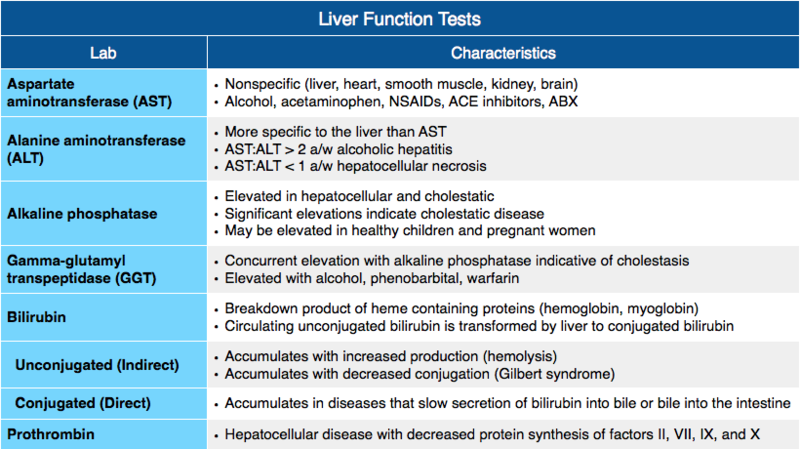
High and low levels, and what do results mean
An AST blood test measures levels of aspartate aminotransferase (AST) and helps determine liver function. Too much of this enzyme can indicate a problem, such as liver damage.
Aspartate aminotransferase (AST) is an enzyme mostly found in the liver. AST is also present in other parts of the body, including the:
- kidneys
- heart
- muscles
Another name for the AST enzyme is serum glutamic-oxaloacetic transaminase (SGOT).
Most people have low levels of the AST enzyme. Damage to liver cells can cause the release of extra AST into the blood though, leading to higher levels of the enzyme.
After taking a blood test, doctors will classify AST ranges as normal, high, or low. Laboratories may use different testing methods for analyzing samples, so normal ranges can vary between each laboratory.
There is not an exact range for AST levels, as levels can vary among people and still be normal. AST levels can vary depending on factors such as:
AST levels can vary depending on factors such as:
- age
- sex
- weight
- race
The measurements for AST levels are typically in units per liter (U/L) or international units per liter (IU/L). On a test result, the laboratory will usually list their specific reference range.
People will need to look at this reference range and discuss with their doctor what their test results mean for them. To understand the results of an AST blood test, a doctor will also look at other enzymes that can indicate a liver problem.
The following table indicates general AST blood test ranges. However, reference ranges can vary slightly among different laboratories.
| Adults | Children | |
|---|---|---|
| Normal | 10–40 IU/L | |
| High | >36 U/L >1,000 U/L are very high levels and may be a sign of liver injury or hepatitis | >40 IU/L which may be a sign of liver inflammation |
Results from an AST blood test can help indicate liver health.
If AST levels are high, it may also be a sign of:
- chronic hepatitis
- damage from alcohol
- cholestasis, a decrease in bile flow
- heart, kidney, bone, or muscle damage
- liver cancers
- liver scarring, known as liver cirrhosis
Very high AST levels are usually a sign of progressing liver damage, often due to acute hepatitis.
Low AST levels may indicate:
- vitamin B6 deficiency
- kidney disease
- liver disease
- cirrhosis
- cancer
- autoimmune conditions
- genetic conditions
A doctor may also test levels of alanine aminotransferase (ALT), another liver enzyme. ALT levels occur in higher concentrations in the liver.
If ALT levels are normal but AST levels are high, it could indicate a health problem outside of the liver, or it may be a sign of alcohol-induced liver damage.
Having high levels of AST and no other signs of a problem is not necessarily a cause for concern.![]() People with normal liver function can have high AST levels, which may be due to:
People with normal liver function can have high AST levels, which may be due to:
- age
- sex
- race
- certain medications
A person should always discuss any medications or health products they take with a doctor.
Doctors primarily use the AST blood test to check for and assess liver problems, usually alongside other liver tests. The AST protein mainly occurs in the liver and heart. With liver damage, AST can leak from the liver into the bloodstream. When this happens, AST levels in the blood will be higher than normal.
AST also occurs in the brain, heart, kidneys, and muscles. If there is damage in any of these areas, AST levels may also increase.
To rule out issues affecting areas outside the liver, doctors may order a check of the second liver enzyme, ALT, at the same time. If both levels are high, it may indicate a problem with a person’s liver. If only AST levels are high, this may indicate a problem with another organ or system.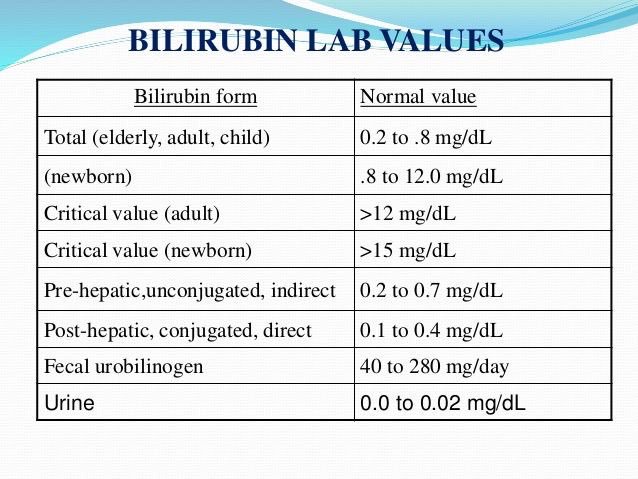
People may have an AST test for screening, diagnosis, or monitoring purposes. A doctor may recommend this test if a person:
- has risk factors for liver disease, such as family history, obesity, or diabetes
- has symptoms of a liver problem, such as jaundice, fatigue, or unexplained weight loss
- is undergoing treatment for a liver condition, as an AST blood test can help show how well treatment is working
Alanine aminotransferase (ALT) is an enzyme that mostly occurs in the liver. If there is damage to liver cells, ALT levels in the bloodstream can increase. An ALT test can help indicate liver health, along with other liver enzyme tests.
Healthcare professionals may use both ALT and AST tests to check for the presence of liver enzymes in the blood, as this can give them a clearer idea of overall liver function and health.
Learn more about the ALT test here.
The AST blood test is straightforward and similar to any other blood test. A healthcare professional may take the following steps:
A healthcare professional may take the following steps:
- sit the person down and tie a stretchy band around the upper arm to increase blood flow to that area
- clean the site of the blood draw with an antiseptic wipe
- insert a needle into a vein in the arm to take a blood sample, which may cause people to feel a mild prick or pain
- remove the needle once they have drawn enough blood
- send the blood sample to a laboratory for testing
An AST blood test will usually only take a few minutes in total.
In some cases, people may be able to take an AST test at home. Using an at-home test kit, people will take a blood sample from their fingertip and send the sample to a laboratory. People may receive AST blood test results through the mail, an app, or an online system.
Learn how long it might take to receive blood test results here.
Preparation
People may need to fast for several hours if they are having a combination of liver enzyme tests.
If people are only having an AST blood test, they may not need to fast or prepare in any way.
People will need to let their doctor know if they are taking any medications or supplements, as some may interfere with liver enzyme levels.
As a healthcare professional will be taking blood from the arm, it may be helpful to wear short sleeves during the test.
As with any blood test, an AST blood test has very few risks. It is rare to experience any severe side effects, but people may have some mild bruising or discomfort in the area at the site of the blood draw.
A healthcare professional will place a Band-Aid or bandage on the arm to stop any bleeding.
People may want to have something to eat after the test, particularly if they were fasting beforehand. It is safe for people to drive and continue their usual activities after an AST blood test, unless they experience any unusual symptoms.
A doctor may order tests along with an AST blood test or follow-up tests.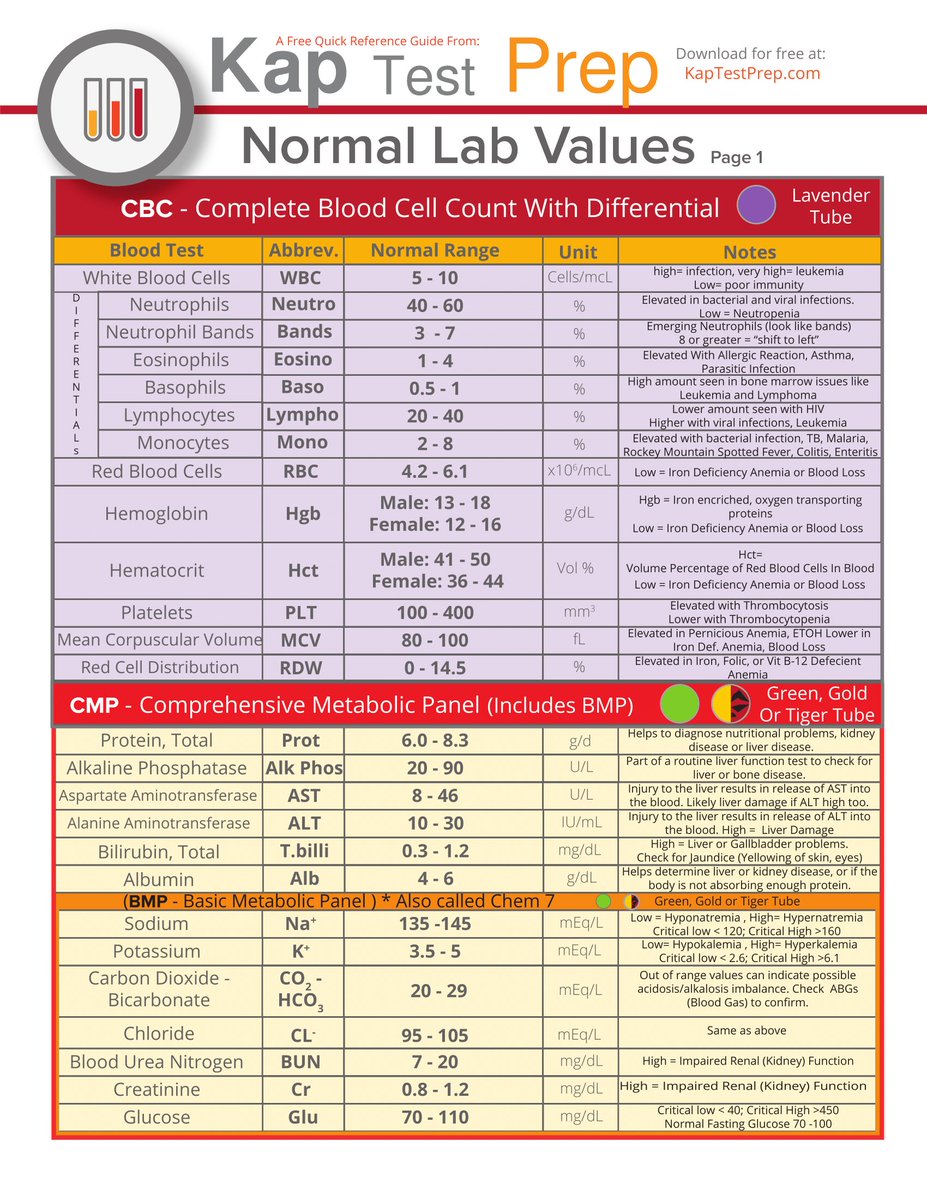 This is to help ensure proper diagnosis and determine the best course of treatment. These tests may include:
This is to help ensure proper diagnosis and determine the best course of treatment. These tests may include:
- ALT test: A doctor may order an ALT test alongside an AST test.
- Platelet count: Low platelet levels may indicate HELLP syndrome during pregnancy.
- Coagulation panel: This measures the functioning of clotting-related proteins that the liver produces.
- Complete metabolic panel: This assesses how well the kidneys and liver are working and shows levels of electrolytes.
- Bilirubin test: A bilirubin test checks levels of a byproduct created when the liver breaks down red blood cells.
- Glucose test: High or low blood glucose levels may indicate a liver problem.
- Viral testing: This can help doctors check for hepatitis.
- Imaging: A doctor may order images of the liver via ultrasound.
The extent of follow-up testing will depend on a person’s results. A doctor may also take additional blood tests, imaging tests, or a biopsy to identify or rule out any potential conditions relating to abnormal AST levels.
A doctor may also take additional blood tests, imaging tests, or a biopsy to identify or rule out any potential conditions relating to abnormal AST levels.
Learn about different types of blood tests here.
An AST blood test, or SGOT test, checks how much AST, a liver enzyme, is present in the blood. High levels of AST in the bloodstream could be a sign of liver damage, or cell damage in another organ such as the heart or kidneys.
Doctors may also take additional tests to check other liver enzymes, such as ALT, to get more information on the health of the liver.
what are the norms and what does the deviation mean?
Contents
- 1 Normal ALT and AST values in women: how to evaluate your liver
- 1.1 ALT and AST – what are they?
- 1.2 Related videos:
- 1.3 Blood test for ALT and AST
- 1.4 Normal ALT and AST in women
- 1.5 Abnormal ALT and AST from the norm
- 1.6 Reasons for increasing the level of ALT and AST in women
- 1.
 7 Diseases that cause elevated levels of ALT and AST in women
7 Diseases that cause elevated levels of ALT and AST in women- 1.7.1 Hepatitis
- 1.7.2 Cirrhosis of the liver
- 1.7.3 Obesity
- 1.7.4 Other diseases
- 1.8 Symptoms of elevated levels of ALT and AST in women 9000 8
- 1.9 Diagnosing elevated ALT and AST
- 1.10 What to do with elevated ALT and AST
- 1.11 Treating elevated ALT and AST
- 1.12 Nutrition for elevated ALT and AST
- 1. 12.1 Introduction
- 1.12.2 What to use
- 1.12.3 What to avoid
- 1.12.4 Cooking tips
- 1.12.5 Conclusion
- 1.13 Prevention of elevated ALT and AST
- 1.14 Consequences of elevated ALT and AST levels
- 1.15 Comparison with elevated levels of other blood parameters
- 1.16 ALT and AST testing for hepatitis
- 1.16.1 Alanine aminotransferase and Aspartate aminotransferase
- 1.16 .2 How to prepare for an ALT and AST test
- 1.
 16.3 What the test results mean
16.3 What the test results mean
- 1.17 Effects of ALT and AST on pregnancy
- 1.18 When to see a doctor if ALT and AST levels are elevated
- 1.19 Q&A:
- 1.19.0.1 What are Alt and Ast and why are these indicators needed in the analyzes of women?
- 1.19.0.2 What are the normal levels of Alt and Ast in women?
- 1.19.0.3 What can cause an increase in Alt in women?
- 1.19.0.4 What causes an increase in the Ast level in women?
- 1.19.0.5 What does low Alt mean in women?
- 1.19.0.6 What can it mean if the level of Alt and Ast is simultaneously elevated in women?
- 1.19.0.7 Can a low Ast level in women indicate the absence of liver problems?
- 1.19.0.8 How long do elevated levels of Alt and Ast persist in women after drinking alcohol?
Find out which ALT and AST values are normal for women. Useful information about the functions of these indicators and the causes of deviations from the norm.
Alt and Ast are enzymes that are responsible for the functioning of the liver. If their blood levels are elevated, this may indicate a liver problem. A blood test for alt and ast is usually ordered in case of suspected liver disease, but what does a deviation in the level of these enzymes mean in women?
ALT and AST blood levels in women depend on many factors, including age, sex, disease, and medication. But in general, the alt level in women should not exceed 31 units/l, and the ast level should not exceed 34 units/l.
Abnormal alt and ast levels in women may indicate liver problems such as hepatitis, cirrhosis, tumors, and gallstones. However, keep in mind that elevated levels of alt and ast are not always indicative of liver disease. Some medications, such as aspirin, pain pills, and antibiotics, can increase blood levels of these enzymes.
If you have been tested for alt and ast and your blood levels of these enzymes are elevated, be sure to discuss the results with your doctor.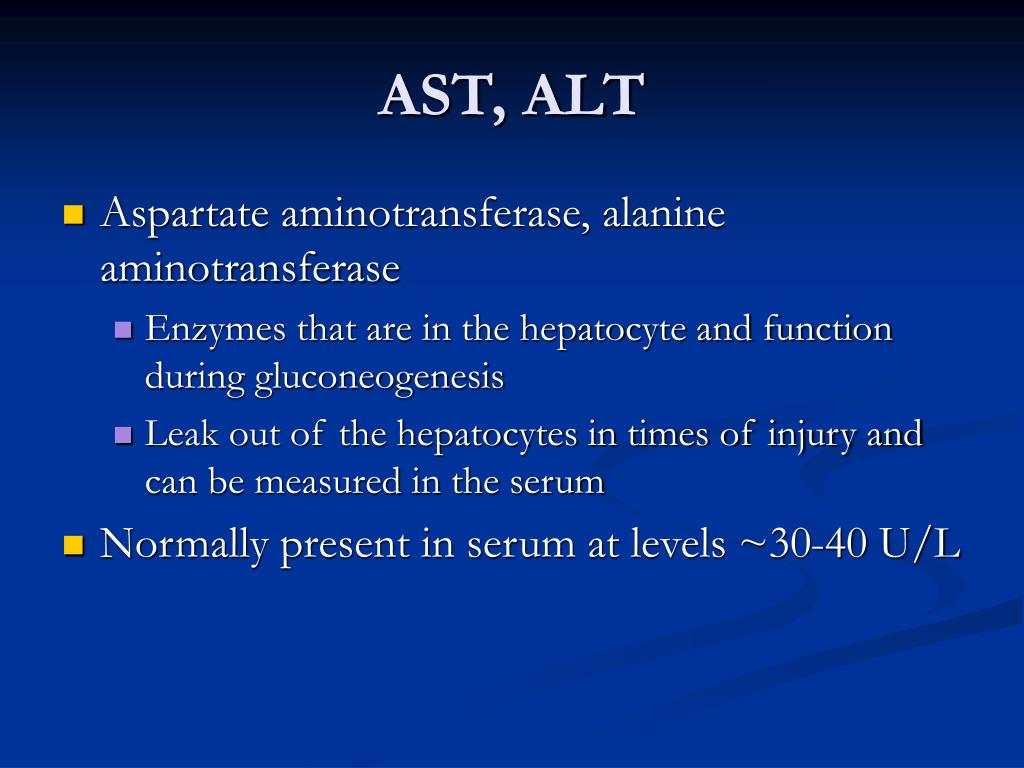 He will be able to assess your ALT and AST levels in the context of your health and determine if additional testing or treatment is needed.
He will be able to assess your ALT and AST levels in the context of your health and determine if additional testing or treatment is needed.
ALT and AST – what is it?
Alanine aminotransferase (ALT) and aspartate aminotransferase (AST) are enzymes found inside liver cells. If liver cells are damaged or destroyed, these enzymes enter the bloodstream. Therefore, an increase in the level of ALT and AST in the blood may indicate the presence of problems with the liver or other organs.
ALT is mainly present in liver cells, but can also be found in heart cells and other tissues. AST is present in the cells of the liver, heart, muscles and other organs.
ALT and AST are often used together in the diagnosis of liver diseases such as hepatitis and cirrhosis. These enzymes can also be elevated in myocardial infarction, rheumatic diseases, and other problems.
Related videos:
youtube.com/embed/e85W3VHgk_M” frameborder=”0″ allowfullscreen=”allowfullscreen”>
Blood test for ALT and AST
Blood test for ALT (alianine aminotransferase) and AST (aspartate aminotransferase) is one of the most common methods for diagnosing diseases of the liver and heart. Both are enzymes that are normally found inside the cells of the liver and heart, but if these organs become damaged or inflamed, ALT and AST are released from the cells into the blood, causing their blood levels to rise.
ALT is routinely screened to diagnose liver diseases such as hepatitis, cirrhosis, and liver cancer. ALT levels can also be elevated with certain medications, jaundice, gallbladder disease, and inflammatory diseases of the biliary tract.
AST, on the other hand, can be elevated in a number of conditions, including heart disease, myocardial infarction, liver disease, and muscle disease. AST levels can also be elevated when taking certain medications.
Elevated levels of ALT and AST in the blood may indicate a specific disease, but these indicators cannot indicate a specific condition. To detect the disease, additional research and examinations are necessary.
In general, elevated levels of ALT and AST usually indicate damage to some organs in the body. If you are found to have elevated levels of ALT or AST, you should undergo further tests to find out which organs are damaged and begin treatment under the guidance of a qualified physician.
Yes
100%
ALT and AST levels in women
Alanine aminotransferase (ALT) and aspartate aminotransferase (AST) are indicators of liver function. Normal blood levels of these enzymes may vary depending on the methodology of the laboratory, as well as the age, sex, and weight of the patient. However, on average, ALT and AST in women have the following norms:
- ALT: up to 34 units / l;
- AST: up to 31 units/l.
If a woman’s ALT and AST levels are higher than normal, this may indicate liver problems such as inflammation, fatty degeneration, or cirrhosis. However, another underlying cause may also be present, such as alcohol or drug poisoning, drug injection, or heart or muscle disease.
However, another underlying cause may also be present, such as alcohol or drug poisoning, drug injection, or heart or muscle disease.
If you have been prescribed ALT and AST tests and find that these levels are abnormal, you should consult your doctor to determine the cause and prescribe the appropriate treatment.
ALT and AST abnormal
Alanine aminotransferase (ALT) and aspartate aminotransferase (AST) are enzymes that help the body make proteins. Normal levels of ALT and AST in women can vary, but are usually in the range of 7-56 units/L for ALT and 10-40 units/L for AST.
Abnormal ALT and AST levels may indicate the presence of liver disease such as hepatitis or cirrhosis. If the level remains elevated for a long time, it can lead to serious complications, including liver failure or liver cancer.
ALT and AST levels may also be elevated in other conditions such as myocardial infarction, pneumonia, or myopathies. This can help diagnose these conditions and track their treatment.
If the levels of ALT and AST strongly deviate from the norm, it is recommended to consult a doctor for additional examination and determination of the cause of such deviation. Early detection and treatment of diseases that can lead to elevated levels of ALT and AST can help maintain health and prevent serious complications.
Causes of increased levels of ALT and AST in women
AST (aspartate aminotransferase) and ALT (alanine aminotransferase) are enzymes that are involved in the process of amino acid metabolism. They are found in the cells of the liver, heart muscle, kidneys and other tissues of the body. If ALT and AST levels are elevated in a woman, this may indicate the presence of the following reasons:
- Liver disease: elevated levels of ALT and AST may indicate the presence of hepatitis, liver cirrhosis, fatty degeneration and other pathological changes. At the same time, ALT levels may rise earlier than AST.
- Taking medications: Many medications can increase blood levels of ALT and AST.
 This is especially true of hepatotoxic drugs that have a negative effect on the liver.
This is especially true of hepatotoxic drugs that have a negative effect on the liver. - Alcoholic liver injury: the presence of an alcoholic mixture can lead to elevated levels of ALT and AST.
- Myocarditis, hypoxia of the heart muscle: when the heart muscle is affected, AST levels can rise much faster than ALT.
- Non-specific elevation: ALT and AST levels may be elevated with various infectious diseases, trauma and surgery.
In any case, if the level of ALT and AST in a woman is elevated, this requires a mandatory examination and identification of the cause in order to prescribe an effective treatment.
Diseases that cause elevated levels of ALT and AST in women
Hepatitis
Elevated levels of ALT and AST may be associated with hepatitis, an inflammation of the liver that can be caused by viruses, alcohol, drugs, and other factors. In hepatitis, ALT and AST are higher than normal due to damage to liver cells and the release of enzymes into the blood.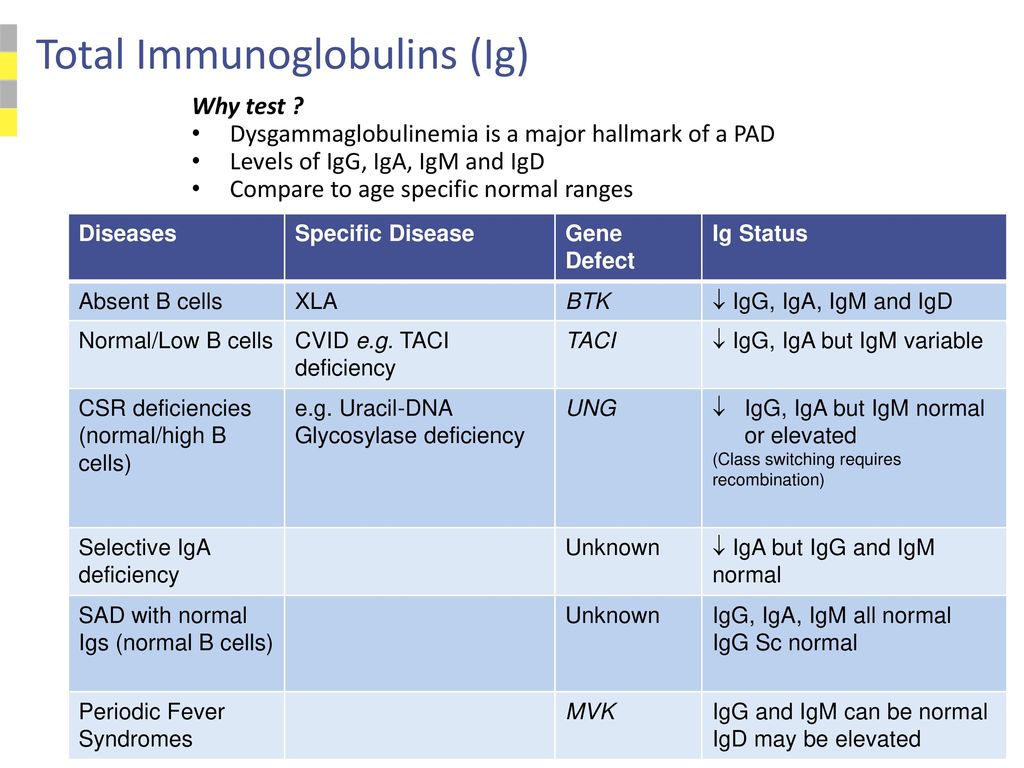
Cirrhosis of the liver
Cirrhosis of the liver is characterized by the gradual accumulation of damage to the liver cells, which can cause an increase in the level of ALT and AST. With cirrhosis of the liver, the function of the organ is impaired, which can lead to serious consequences.
Obesity
Obesity can be one of the causes of elevated levels of ALT and AST. Fat accumulates in the liver, which can cause it to malfunction and release enzymes into the blood.
Other diseases
Elevated levels of ALT and AST may also be associated with rarer diseases such as myopathy, muscle wasting, thrombosis, myocardial infarction and others. You need to see a doctor for an accurate diagnosis and treatment.
Symptoms of elevated ALT and AST levels in women
ALT (alanine aminotransferase) and AST (aspartate aminotransferase) are enzymes found inside the cells of the liver and other organs. Elevated levels of ALT and AST in the blood can indicate problems with the liver, heart, muscles, and other organs.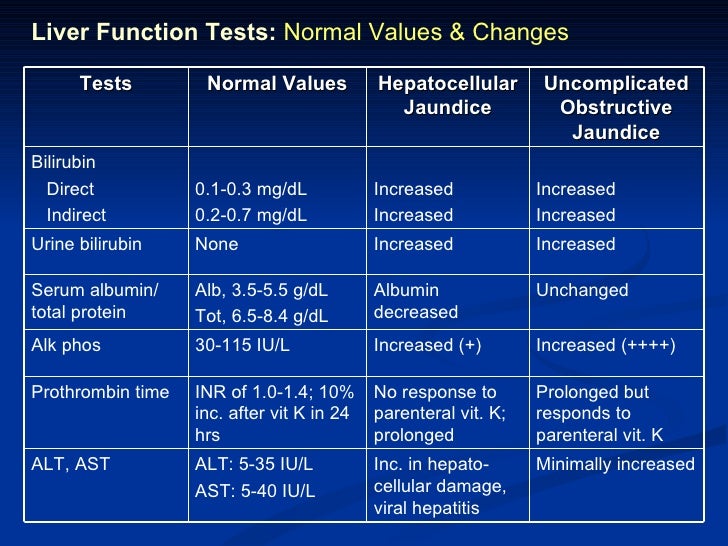
In women, elevated levels of ALT and AST may present with the following symptoms:
- Jaundice (a yellowish tinge to the skin and whites of the eyes)
- Enlargement of the liver and spleen
- Nausea and vomiting
- Increased fatigue and weakness
- Decreased appetite
- Pain in the abdomen or in the right upper quadrant of the abdomen
- Hypersensitivity to drugs and alcohol
- Muscle pain and spasms
If you notice any of these symptoms, you should see a doctor for diagnosis and treatment. He may order blood tests for ALT and AST levels, as well as other types of tests to identify possible problems with the body.
Do not ignore the symptoms of elevated levels of ALT and AST, as these enzymes can indicate serious diseases that require competent medical attention.
Diagnosis of elevated levels of ALT and AST
A special blood test is performed to detect the level of hormones ALT and AST.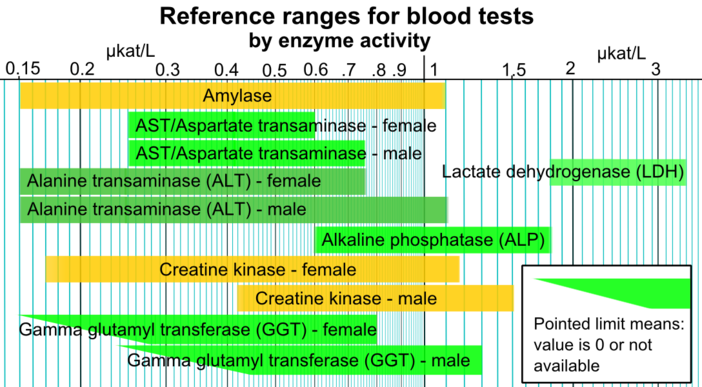 This test can help diagnose various diseases of the liver, heart, and muscles.
This test can help diagnose various diseases of the liver, heart, and muscles.
ALT and AST levels may be elevated in the presence of viral hepatitis, alcoholic or toxic hepatitis, liver cirrhosis, infectious mononucleosis, heart and muscle disease. In some cases, an increase in hormone levels may be due to medications taken or tissue damage resulting from an injury.
If the ALT and AST levels are above normal, further investigations are needed to determine the cause of the deviation. Do not panic in advance, because elevated hormone levels do not always indicate a serious illness.
It is important to understand that self-monitoring of ALT and AST levels at home is not sufficient to establish a diagnosis. To do this, you should consult a doctor and perform the recommended tests.
What to do with elevated ALT and AST
If you have been diagnosed with elevated levels of ALT and AST in the blood, do not panic, but do not ignore this fact either. First you need to determine the reason for such a deviation. Usually, elevated levels of ALT and AST indicate complications in the liver.
Usually, elevated levels of ALT and AST indicate complications in the liver.
If elevated levels of ALT and AST are caused by a disease or infection, then the doctor may prescribe appropriate treatment, which is aimed at eliminating the reasons for the increase in these levels.
However, sometimes elevated levels of ALT and AST may indicate the presence of chronic diseases of the liver or other organs. In this case, it is necessary to undergo an examination to determine the causes of this condition and prescribe a suitable treatment.
To lower your ALT and AST levels, you need to follow a proper diet, stop bad habits, take the right medications, and have regular medical checkups.
In any case, ALT and AST levels should be monitored regularly. If you find deviations from the norm, you should consult a doctor in a timely manner and undergo an additional examination to find out the causes and prevent possible complications.
Treatment of elevated ALT and AST
As markers of liver damage, ALT and AST are important indicators of liver disease. If ALT and AST levels are high, treatment depends on the underlying cause of the condition.
If ALT and AST levels are high, treatment depends on the underlying cause of the condition.
If elevated levels of ALT and AST are due to alcoholic or viral hepatitis, then the main treatment is the treatment of the underlying disease. In cases of liver failure, increased protein intake and dietary elasticity may be prescribed.
If elevated levels of ALT and AST are associated with medication or supplements, then these drugs should be discontinued. You may have to replace them with safer alternatives.
For people with elevated ALT and AST levels, it is imperative to control alcohol consumption and the abuse of fatty, rich foods.
Based on the above, you need to understand that elevated levels of ALT and AST require careful consideration and analysis of the causes. Only then can you find the appropriate treatment and make the necessary adjustments in your lifestyle and diet.
Nutrition with elevated ALT and AST levels
Introduction
Women with elevated ALT and AST levels should pay attention to their diet.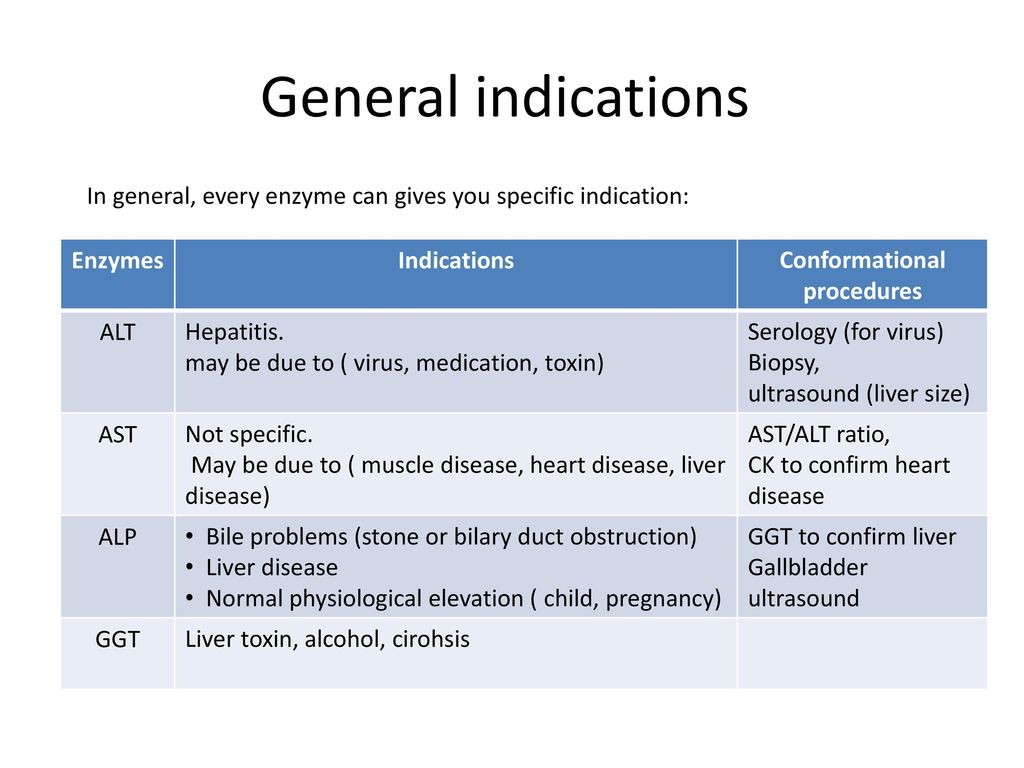 Diet can have a big impact on the levels of these enzymes in the blood, so it is recommended to follow certain rules when compiling your daily menu.
Diet can have a big impact on the levels of these enzymes in the blood, so it is recommended to follow certain rules when compiling your daily menu.
What to eat
When ALT and AST levels are elevated, a healthy diet is given special attention. Women should eat more fresh fruits and vegetables, as well as protein foods such as fish, chicken, eggs, and cottage cheese. It is also recommended to drink plenty of fluids, including clean water.
What to avoid
Women should limit their intake of fatty and fried foods, as well as sweets and alcohol, to avoid elevated ALT and AST levels. In addition, it is recommended to avoid too much coffee and strong tea.
Cooking Tips
One way to preserve the benefits of food is to prepare it properly. Women should prefer steamed or grilled dishes. Also, if possible, it is necessary to exclude frying in oil and give preference to cold appetizers and salads.
Conclusion
By following simple healthy dietary guidelines, women can lower their blood levels of ALT and AST. Regular consumption of fresh fruits and vegetables, protein foods, limiting fatty, fried and sugary foods, and proper cooking will help maintain a healthy liver and improve overall body health.
Regular consumption of fresh fruits and vegetables, protein foods, limiting fatty, fried and sugary foods, and proper cooking will help maintain a healthy liver and improve overall body health.
Preventing elevated ALT and AST levels
Maintaining a healthy liver and preventing elevated ALT and AST levels in women requires a healthy lifestyle:
- Avoid alcohol and nicotine;
- Watch your diet and avoid fatty, fried and salty foods;
- Maintain a healthy weight and avoid excess weight;
- Exercise regularly;
- Avoid stress and nervous overload;
- Monitor the level of hormones in the body, especially when taking hormonal drugs.
It is also recommended to undergo regular medical examinations and seek medical attention at the first symptoms of liver disease: pain in the right hypochondrium, nausea, vomiting, jaundice, loss of appetite and drowsiness.
If the level of ALT and AST in the blood of a woman is elevated, then it is necessary to consult a doctor for additional examination and determination of the cause of the deviation.
Sample diet to prevent elevated ALT and ASTV Time Meal
| 8:00 | Breakfast: oatmeal with water, apple, green tea |
| 11: 00 | Snack: fruit yogurt, nuts |
| 14:00 | Lunch: grilled chicken breast, steamed vegetables, a piece of rye bread, water |
| 17:00 9 0330 | Snack: fresh vegetables, rye bread toast, green tea |
| 20:00 | Dinner: steamed fish, vegetable salad, slice of rye bread, water |
Consequences of elevated levels of ALT and AST
Elevated levels of ALT and AST usually indicate liver dysfunction. Such violations can be caused by various reasons: from alcohol or drug intoxication to viral infections or cancer.
One of the first signs of elevated levels of ALT and AST are yellowing eyes and skin, which indicate a violation of the outflow of bile. Other signs may include pain in the right side, bloating, nausea, vomiting, and general weakness.
These signs should not be ignored, as elevated levels of ALT and AST can lead to serious consequences. For example, it can cause cirrhosis of the liver, which in turn can lead to liver cancer and other dangerous diseases. Therefore, if suspicious symptoms appear, you should consult a doctor and undergo an appropriate examination.
- Suspected or developing acute hepatitis
- Confirmed chronic hepatitis
- Suspected gallbladder disease
- May be caused by certain drugs or high alcohol intake
If found elevated a high level of ALT and AST, measures must be taken to eliminate the cause of its occurrence. For this, special medications, diet, avoidance of alcohol and other suitable measures can be prescribed.
Comparison with elevated levels of other indicators in the blood
The presence of elevated levels of alanine aminotransferase (Alt) and aspartate aminotransferase (AST) can be caused not only by diseases of the liver, cardiovascular system and muscle tissue, but also by the presence of other indicators in the blood, such as iron, glucose, cholesterol and others.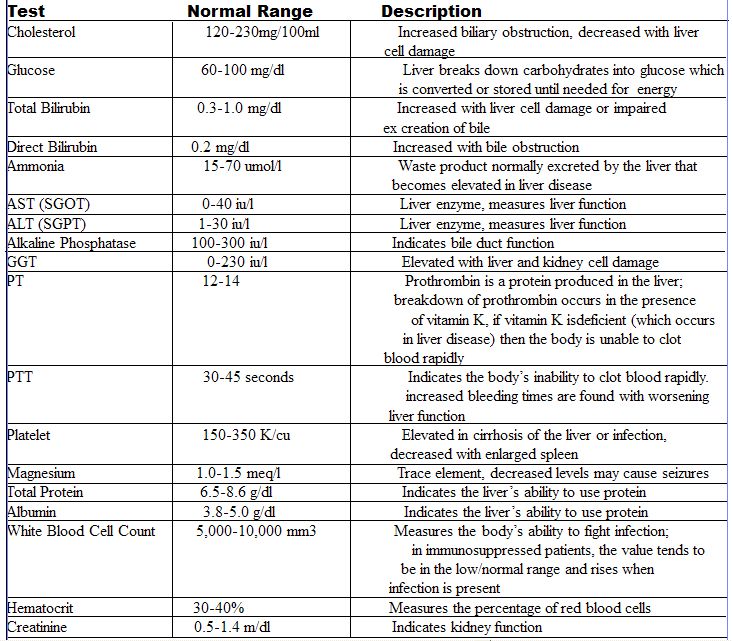
When comparing the levels of Alt and Ast with other indicators, it is necessary to take into account the possible mechanisms for increasing the levels of these enzymes. For example, an increase in the level of Alt and Ast may be associated with a violation of iron metabolism in the body, which leads to its accumulation in the liver and intensive destruction of liver cells.
However, in the presence of elevated levels of Alt and Ast in combination with other indicators, it is necessary to conduct an additional examination to determine the cause of the increase and further treatment.
- Elevated blood glucose may indicate diabetes.
- Elevated cholesterol levels may be associated with impaired lipid metabolism in the body.
- Elevated iron levels may indicate the presence of hemochromatosis.
ALT and AST hepatitis test
Alanine aminotransferase and Aspartate aminotransferase
ALT and AST are enzymes that are found inside liver cells. They are involved in the metabolism of amino acids and help the body get energy from food. High levels of ALT and AST can indicate liver problems, which is why they are usually included in a standard CBC.
They are involved in the metabolism of amino acids and help the body get energy from food. High levels of ALT and AST can indicate liver problems, which is why they are usually included in a standard CBC.
One of the most common blood tests for ALT and AST levels is a hepatitis test. Hepatitis is an inflammatory disease of the liver that can be caused by infection, alcohol, or toxins. ALT and AST may be elevated in viral hepatitis, and their rise may reflect the degree of liver damage.
How to prepare for an ALT and AST test
To prepare for an ALT and AST test, you must give blood samples. No other special preparatory measures are required. However, alcohol consumption should be limited prior to testing, as it can increase blood levels of ALT and AST.
What the test results mean
The normal range for ALT and AST levels in the blood may vary depending on the laboratory that performs the test. Generally, ALT and AST levels should not exceed 30 to 40 units per liter (U/L) in women. If the level of ALT and AST is elevated, then this may indicate a toxic or infectious liver lesion.
If the level of ALT and AST is elevated, then this may indicate a toxic or infectious liver lesion.
If the results of the analysis show high levels of ALT and AST, then it is necessary to consult with your doctor to identify the possible cause of the elevated ALT and AST levels and begin treatment.
The effect of ALT and AST on pregnancy
ALT and AST are indicators that can be measured in the blood of a pregnant woman at different stages of pregnancy. They play an important role in assessing the health of the liver, but can also indicate problems with the heart and muscles.
Studies show that elevated levels of ALT and AST in the blood of a pregnant woman can indicate the presence of infection, hepatitis, many other diseases, and also negatively affect the development of the child.
Although elevated levels of ALT and AST alone are not dangerous for pregnancy, if the levels of both are elevated, action must be taken. In this case, the woman should consult a doctor and undergo additional examinations.
In addition, maintaining a healthy lifestyle and proper diet can help reduce the risk of elevated ALT and AST levels. Pregnant women need to pay special attention to their health and monitor the level of these indicators in the blood in order to ensure the health of their child and themselves in general.
When to see a doctor if ALT and AST levels are elevated
If a woman’s blood levels of alanine aminotransferase (ALT) and aspartate aminotransferase (AST) are elevated, it may be a symptom of various diseases of the liver, cardiovascular system and other organs.
If a woman notices symptoms such as fatigue, nausea, jaundice, right upper quadrant tenderness, she should seek immediate medical attention.
It is also recommended that women undergo regular medical examinations in order to identify possible problems of the disease at an early stage.
To diagnose the level of ALT and AST, it is necessary to donate blood for biochemical analysis, which can determine the presence of pathological changes.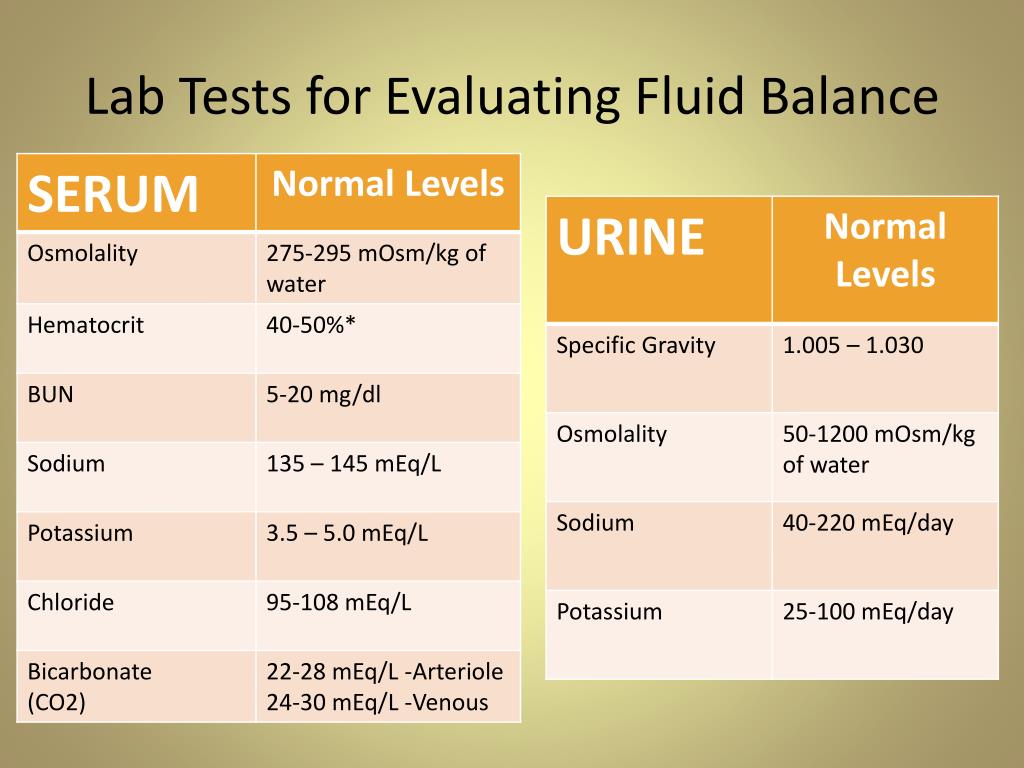
If ALT and AST levels are elevated, the doctor may order additional tests to determine the cause of the abnormality and prescribe appropriate treatment.
Question-answer:
What are Alt and Ast and why are these indicators needed in the analyzes of women?
Alt (alanine aminotransferase) and Ast (aspartate aminotransferase) are enzymes that are found in liver cells and are involved in amino acid metabolism. Their blood levels help diagnose liver disease and assess liver function. When deviating from the norm, Alt and Ast can indicate various pathologies that need to be identified and treated.
What are the normal levels of Alt and Ast in women?
The norm of Alt in women is 10-40 U/l, and the norm of Ast is 10-30 U/l. However, these values may differ depending on the laboratory that performs the analysis. Therefore, when studying the results, it is necessary to be guided by the standards specified in the laboratory where the analyzes were carried out.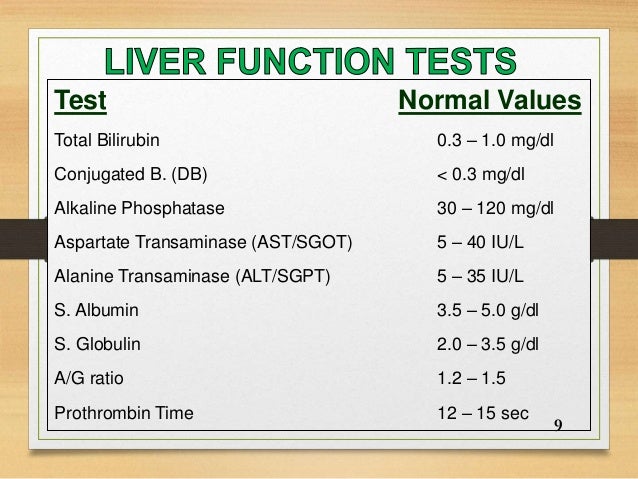
What can cause an increase in Alt in women?
An increase in the level of Alt in the blood in women can be caused by diseases such as viral hepatitis, cirrhosis of the liver, fatty liver, as well as alcohol or toxic drugs. Also, an increase in Alt levels may be associated with muscle damage, along with damage to liver cells.
What causes an increase in Asth levels in women?
An increase in the level of Ast in the blood in women can be caused by liver pathologies (cirrhosis, hepatitis), myocardial infarction, encephalopathy, jaundice. Also, an increase in the level of Ast can be observed in oncological diseases, alcoholism and the use of toxic drugs.
What does low Alt mean in women?
Decrease in the level of Alt in the blood is not a pathology and in itself does not cause any symptoms. However, if the Alt level is reduced, but the Ast level remains normal, then this may indicate a violation of liver function and require further examination and diagnosis.
What can it mean if the level of Alt and Ast is simultaneously increased in women?
Simultaneous elevation of Alt and Ast may indicate various liver diseases such as hepatitis, cirrhosis or cancer. Also, an increase in the level of Alt and Ast may be associated with dysfunction of other organs, such as skin, muscles and pancreas. The final diagnosis can only be made after a comprehensive examination and exclusion of other pathologies.
Can a low Ast level in women indicate the absence of problems with the liver?
No, low Ast levels in the blood are not a sufficient criterion for assessing the health of the liver. For a complete diagnosis, it is necessary to conduct a comprehensive examination and analysis of other biochemical blood parameters that will help identify possible pathologies.
How long do elevated Alt and Ast levels persist in women after drinking alcohol?
Increased levels of Alt and Ast in the blood of women may persist up to 4-5 days after drinking alcohol. The more often and more alcohol is consumed, the longer elevated levels of these indicators persist. Stopping alcohol consumption helps bring Alt and Ast levels back to normal levels. However, if elevated levels of Alt and Ast do not decrease for a long time, additional diagnostics and examination are necessary.
The more often and more alcohol is consumed, the longer elevated levels of these indicators persist. Stopping alcohol consumption helps bring Alt and Ast levels back to normal levels. However, if elevated levels of Alt and Ast do not decrease for a long time, additional diagnostics and examination are necessary.
The norm of ALT and AST levels in a blood test in women: what you need to know?
Contents
- 1 ALT and AST norms in women’s blood tests
- 1.1 Women’s blood tests
- 1.2 What are ALT and AST?
- 1.3 The value of ALT and AST in the blood test
- 1.4 Normal levels of ALT and AST in women
- 1.5 The effect of age on the level of ALT and AST
- 1.6 Causes of elevated levels of ALT and AST
- 1.7 Liver disease and ALT and AST levels
- 1.8 Cardiovascular disease and ALT and AST levels
- 1.9 Causes of low ALT and AST levels
- 1.10 Related videos:
- 1.11 Q&A:
- 9000 5 1.
 11.0.1 What are ALT and AST?
11.0.1 What are ALT and AST?- 1.11.0.2 Why do I need to measure blood levels of ALT and AST?
- 1.11.0.3 What are the ALT and AST norms for women?
- 1.12 Liver disease and low ALT and AST levels
- 1.13 Vitamin deficiency and low ALT and AST levels
The norm of the level of ALT (alanine aminotransferase) and AST (aspartate aminotransferase) in the blood test in women. What values are considered normal and what may indicate deviations from the norm. Important indicators for diagnosing the condition of the liver and heart.
ALT (alanine aminotransferase) and AST (aspartate aminotransferase) are enzymes that are found inside liver and heart cells. They play an important role in the metabolism of amino acids and are involved in the process of energy formation. The study of the levels of ALT and AST in the blood test reveals the presence and extent of damage to these organs.
Normal values of ALT and AST are somewhat different in men and women, due to differences in body physiology. On average, in women, the acceptable level of ALT is from 7 to 35 units per liter, and the level of AST is from 7 to 31 units per liter of blood.
Elevated levels of ALT and AST may be indicative of various diseases and conditions. For example, elevated ALT levels may be associated with liver disease such as hepatitis or cirrhosis, and AST levels may be elevated with myocardial infarction or heart failure. However, elevated values of these enzymes can also indicate other problems in the body, so diagnosis always requires an integrated approach and additional research.
Blood test for women
Blood test is one of the most common and informative laboratory procedures for assessing women’s health. It allows you to identify various deviations and pathologies, as well as monitor the effectiveness of treatment.
One of the key indicators in the blood test are the levels of alanine aminotransferase (ALT) and aspartate aminotransferase (AST).
These enzymes are found in the cells of the liver and heart, respectively, and an increase in them may indicate problems with these organs.
Normal blood levels of ALT and AST in women depend on age and health status. Typically, ALT levels do not exceed 31 U/L and AST levels do not exceed 35 U/L. However, it must be taken into account that these indicators may vary depending on the laboratory and the research method.
Elevated ALT and AST levels in a woman’s blood test can be due to various causes, including liver disease (hepatitis, cirrhosis), heart disease (heart attack, angina pectoris), as well as the use of certain drugs or an alcohol disorder.
For women, regular blood testing is an important tool for maintaining health and preventing serious illness. In case of detection of deviations in the levels of ALT and AST, it is necessary to consult a doctor for additional studies and diagnosis.
What are ALT and AST?
ALT and AST are shorthand for enzymes called alanine aminotransferase (ALT) and aspartate aminotransferase (AST). They are present inside the cells of organs, especially in the liver, heart, muscles and kidneys. Blood levels of ALT and AST can be used to assess the function of these organs.
They are present inside the cells of organs, especially in the liver, heart, muscles and kidneys. Blood levels of ALT and AST can be used to assess the function of these organs.
ALT and AST are enzymes that play a key role in amino acid metabolism in the body. ALT is responsible for the transfer of the amino group from alanine to alpha-ketoglutarate, and AST from aspartate to alpha-ketoglutarate. These enzymes are an integral part of the process of amino acid metabolism and energy metabolism in the body.
ALT and AST are located inside the cells of organs and usually they practically do not penetrate into the blood. However, when cells are damaged, the levels of these enzymes can increase and enter the bloodstream. Elevated ALT levels may indicate liver damage, while elevated AST levels may indicate damage to the liver, heart, or muscles.
Sedentary (less than 5000 steps)
0%
Sedentary (5000 to 10000 steps)
0%
Active (more than 10000 steps)
9000 2 0%
ALT and AST blood count
ALT (alanine aminotransferase) and AST (aspartate aminotransferase) are enzymes that are found inside the cells of organs, especially the liver and heart. When cell integrity is compromised, these enzymes are released into the blood.
When cell integrity is compromised, these enzymes are released into the blood.
ALT and AST can be used to determine the presence or extent of organ damage. Usually, their levels are markedly increased in the presence of liver diseases such as hepatitis or cirrhosis, as well as in heart disease and muscle damage.
ALT and AST values in a blood test can be expressed in different units, but they are usually expressed in units per liter (U/L) or international activity units (IU/L). Normal ALT and AST values depend on the laboratory performing the analysis and may differ in different countries and medical institutions.
In general, normal levels of ALT and AST in a blood test for women may be as follows:
- ALT: 7-35 U/L
- AST: 10-30 U/L
However, it is important to note that normal values may differ slightly depending on the technique used in the laboratory, so the doctor’s advice should be taken into account when interpreting the results.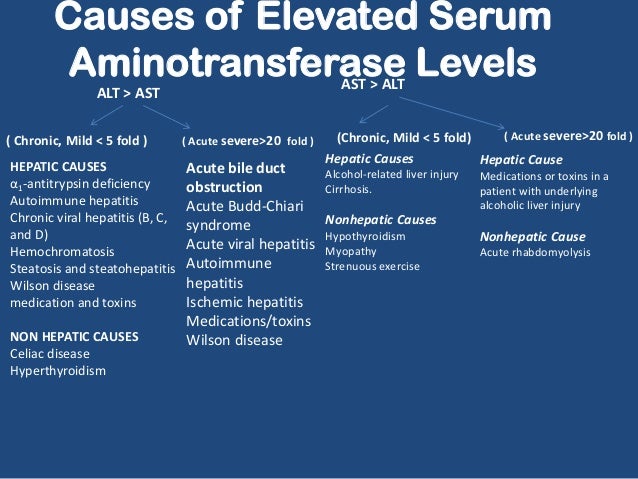
If the levels of ALT and AST in the blood test exceed the norm, this may indicate the presence of a pathological process in the liver, heart or other organs. In this case, the doctor may prescribe additional studies to determine the cause of the increase in these enzymes.
Normal levels of ALT and AST in women
ALT (alanine aminotransferase) and AST (aspartate aminotransferase) are enzymes that are found inside the cells of various organs, including the liver, heart, muscles, kidneys and others. The level of these enzymes in the blood can indicate the condition of these organs.
Normal ALT levels in women vary by analysis and lab, but typically range from 7 to 35 units per litre. Elevated ALT levels can indicate various liver problems such as hepatitis, cirrhosis, or other diseases.
Normal AST levels in women can also vary depending on the analysis, but are usually between 5 and 40 units per liter. Elevated AST levels can indicate a variety of problems, including heart and muscle disease, and liver or kidney damage.
If ALT and AST levels in a woman’s blood are higher than normal, it is recommended to see a doctor for an examination and find out the cause. Diagnosis of the underlying disease that caused the increase in ALT and AST levels will allow prescribing effective treatment and preventing possible complications.
Effect of age on ALT and AST levels
Alanine aminotransferase (ALT) and aspartate aminotransferase (AST) blood levels in women may vary with age. With age, there is often a gradual increase in the levels of these enzymes.
ALT and AST levels may increase in women over 40 due to age-related changes in the body. This is due to the deterioration of metabolic processes, changes in the functional activity of the liver and muscles.
ALT and AST levels can also be affected by age due to the presence of various diseases that can occur with age. Some diseases, such as cirrhosis of the liver, hepatitis, cholecystitis and other pathologies of the biliary tract, can lead to an increase in the level of ALT and AST.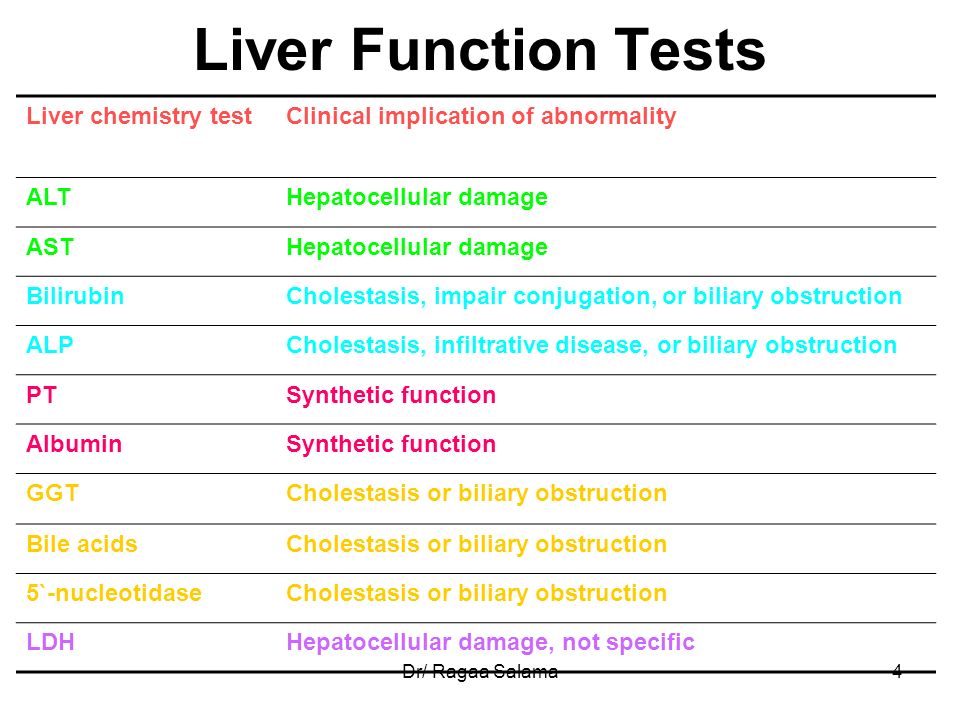
It should be noted that the level of ALT and AST may vary depending on the individual characteristics of the woman. Therefore, when analyzing blood, it is necessary to take into account age, general condition of the body and other factors that can affect the level of these enzymes.
Causes of elevated levels of ALT and AST
Elevated levels of ALT and AST in the blood test in women can be caused by various reasons. This may be due to damage to cells in the liver, heart, muscles, or other organs.
One of the most common causes of elevated ALT and AST levels is liver disease such as cirrhosis or hepatitis. In these diseases, liver cells are damaged and the level of ALT and AST in the blood increases significantly.
Also elevated levels of ALT and AST can be caused by heart problems such as myocardial infarction or heart failure. When the heart muscle is damaged, more ALT and AST are released, which leads to their increase in the blood.
Other causes of elevated ALT and AST levels include the use of certain drugs, alcohol or drug poisoning, mechanical damage to organs or muscles, infectious diseases, and certain genetic disorders.
It is important to note that elevated ALT and AST levels do not always indicate a serious problem and may be temporary or caused by minor causes. However, if elevated levels of ALT and AST persist, it is necessary to consult a doctor for further examination and clarification of the cause.
Liver disease and ALT and AST levels
Alanine aminotransferase (ALT) and aspartate aminotransferase (AST) are enzymes that are found in high concentrations in liver cells. With the development of various liver diseases, such as hepatitis, cirrhosis, fatty degeneration, and others, the levels of ALT and AST can increase significantly.
However, an increase in ALT and AST may not always indicate the presence of a disease. The levels of these enzymes can also be elevated in the event of injury, certain medications, strenuous exercise, and even after drinking alcohol.
To determine the state of the liver and diagnose possible diseases, in addition to ALT and AST levels, a comprehensive blood test is usually performed, including the assessment of other indicators, such as levels of bilirubin, gamma-glutamyl transferase (GGT), alkaline phosphatase, and the diagnostic role of which is also very important.
When ALT and AST levels are abnormal, your doctor may recommend additional tests such as liver ultrasound, Liverscan, liver biopsy, and others. It is important to remember that it is impossible to draw final conclusions about the state of the liver only by the levels of ALT and AST, a comprehensive assessment of all indicators and a medical opinion are required.
Therefore, if you have elevated levels of ALT and AST, do not panic, see a doctor who can diagnose and identify the cause of such changes. Medical care and timely access to a doctor play an important role in assessing the condition of the liver and preventing possible complications.
Cardiovascular disease and ALT and AST levels
Cardiovascular disease is one of the leading causes of death among women worldwide. Often these diseases do not have pronounced symptoms in the early stages, so it is important to regularly monitor your health and conduct tests, including ALT and AST levels.
ALT (alanine aminotransferase) and AST (aspartate aminotransferase) are enzymes found in various organs, including the liver and heart.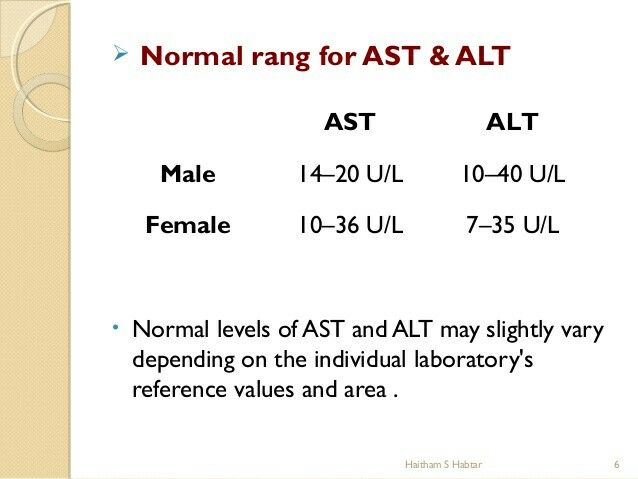 If these organs are damaged, the levels of ALT and AST can increase significantly, indicating the presence of pathological processes.
If these organs are damaged, the levels of ALT and AST can increase significantly, indicating the presence of pathological processes.
The level of ALT in a blood test is an indicator of liver function. With defects and damage to the liver cells, such as cirrhosis or hepatitis, ALT may increase. In addition, elevated ALT levels may indicate the presence of heart failure, which often develops against the background of cardiovascular disease.
At the same time, AST levels can also be an indicator of heart disease. An increase in AST may indicate the presence of myocardial infarction or acute coronary syndrome. However, a simple increase in the level of AST is not a specific indicator of cardiovascular disease, so additional examination is required to clarify the diagnosis.
Thus, the control of ALT and AST levels in the blood test is an important step in the diagnosis of cardiovascular diseases in women. Elevated values of these enzymes may indicate the presence of a pathology, however, an integrated approach and additional examination are required to make an accurate diagnosis and prescribe treatment.
Causes of low levels of ALT and AST
Low levels of ALT (alanine aminotransferase) and AST (aspartate aminotransferase) in the blood test can indicate various diseases and conditions in the body of women.
1. Liver failure: Low levels of ALT and AST may indicate serious liver problems. This may be due to cirrhosis of the liver, chronic hepatitis, hepatic necrosis, or other liver pathologies.
2. Heart disease: Low AST levels may be associated with heart disease such as myocardial infarction, heart failure, or arrhythmias. This is due to the fact that AST is contained in the mitochondria of the heart muscle and its decrease may indicate damage to the heart tissue.
3. Vitamin deficiencies: Low levels of ALT and AST may be due to a lack of important vitamins such as vitamin B6 and vitamin B12. Deficiency of these vitamins can cause abnormalities in the functioning of the liver and heart, which leads to a decrease in the levels of ALT and AST in the blood.
4. Individual features: Some women have low levels of ALT and AST in the blood up to the physiological norm. This may be due to the peculiarities of their metabolism or genetic factors. In such cases, low levels of ALT and AST are usually not dangerous and do not require additional examination or treatment.
It is important to note that low levels of ALT and AST in the blood test require further investigation and consultation with a physician. Only he can determine the specific cause of such changes and prescribe the necessary treatment or observation.
Related videos:
Q&A:
What are ALT and AST?
ALT (alanine aminotransferase) and AST (aspartate aminotransferase) are enzymes found in the cells of the liver, heart, muscles and other organs. They specifically process certain amino acids and help in converting them into energy for the body to work.
They specifically process certain amino acids and help in converting them into energy for the body to work.
Why is it necessary to measure ALT and AST levels in the blood?
Blood levels of ALT and AST can be used to assess the condition of the liver and other organs such as the heart and muscles. Elevated levels of these enzymes may indicate the presence of inflammation or damage to the cells in these organs.
What are the ALT and AST norms for women?
Normal blood levels of ALT and AST may vary slightly between laboratories depending on the methods used. In general, normal ALT levels usually do not exceed 30 U/L and AST levels do not exceed 34 U/L. However, for an accurate interpretation of the results, it is best to consult a doctor who knows the patient’s history and can take into account other factors.
Liver disease and low ALT and AST levels
ALT (alanine aminotransferase) and AST (aspartate aminotransferase) blood values are important indicators of liver function.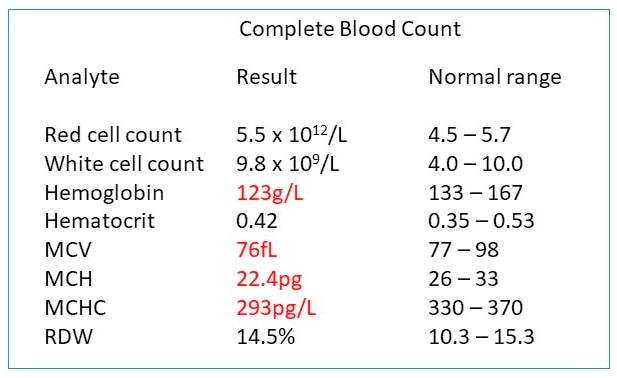 They help determine the presence or absence of damage to the organ. In some liver diseases, however, ALT and AST levels may be low or normal, which can be difficult to diagnose.
They help determine the presence or absence of damage to the organ. In some liver diseases, however, ALT and AST levels may be low or normal, which can be difficult to diagnose.
One cause of low ALT and AST may be liver atrophy. With this disease, the volume of the liver decreases, which leads to a decrease in the activity of enzymes. Another possible cause of low levels of ALT and AST is cirrhosis of the liver, which is characterized by the replacement of healthy organ tissue with scarring. In this case, the number of liver cells that produce ALT and AST decreases, which leads to low levels of these enzymes in the blood.
In addition to atrophy and cirrhosis of the liver, low levels of ALT and AST may be associated with the presence of diseases for the first time that can suppress the functioning of the organ. These diseases include hepatitis and fatty degeneration of the liver. In these pathologies, inflammation and accumulation of lipids in the liver are present, which leads to a decrease in the activity of ALT and AST. This, in turn, may indicate the presence of a progression of the disease or a reactive state of the body.
This, in turn, may indicate the presence of a progression of the disease or a reactive state of the body.
It is important to note that low levels of ALT and AST are not specific signs of specific liver diseases and may be symptoms of various pathologies. Additional studies and analyzes are needed for an accurate diagnosis. Blood test results should be interpreted in the light of other clinical findings and in consultation with the physician.
Vitamin deficiencies and low levels of ALT and AST
A significant decrease in ALT and AST levels in the blood test in women may be associated with a vitamin deficiency. Vitamins are important trace elements necessary for the normal functioning of the body. They are catalysts for many biochemical reactions, including those that regulate ALT and AST levels.
Deficiency of certain vitamins can lead to decreased activity of these enzymes. For example, a lack of vitamin B6 may be associated with low levels of ALT and AST.

 7 Diseases that cause elevated levels of ALT and AST in women
7 Diseases that cause elevated levels of ALT and AST in women 16.3 What the test results mean
16.3 What the test results mean
 This is especially true of hepatotoxic drugs that have a negative effect on the liver.
This is especially true of hepatotoxic drugs that have a negative effect on the liver. 11.0.1 What are ALT and AST?
11.0.1 What are ALT and AST? These enzymes are found in the cells of the liver and heart, respectively, and an increase in them may indicate problems with these organs.
These enzymes are found in the cells of the liver and heart, respectively, and an increase in them may indicate problems with these organs.